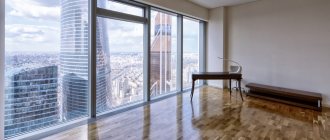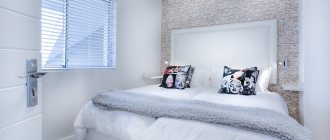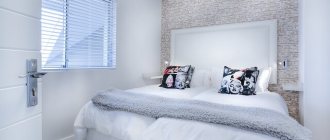Before purchasing a home, we carefully review all possible options and inspect many houses and apartments. When choosing, everything is important: distance from the place of work, child care facilities and social infrastructure, total area, number of rooms. The floor plays a big role. A number of factors should be taken into account: the total number of floors in the house, the presence of an elevator, the health status of family members who will live in the house.
In the article we will look at the features of choosing a floor when buying a home, what are the pros and cons of the first and last floors, which floors are in demand, which are more useful for living, what to choose according to Feng Shui.
Which floor is more environmentally friendly to live on: doctors’ opinion
A person who cares about his own health will certainly think about which floor is not harmful to live on. If we consider the height at which the air is cleaner, it will be the fifth, sixth and seventh floors. Exhaust gases do not rise here, and above the seventh floor harmful emissions from industrial enterprises are already arriving. Residents of the eighth and other upper floors will have to carry out wet cleaning in the apartment more often in order to get rid of particles of pollution that have settled on the surface of furniture and other objects. Doctors are sure that the dirtiest air is found on the first to fifth floors and above the seventh.
At the same time, on the lower floors the percentage of oxygen in the air is higher. Those who live above the fifth floor are advised to frequently ventilate the premises. You can plant large plants with wide leaves in your apartment, which will release oxygen while absorbing carbon dioxide.
People with health problems should prefer an apartment starting from the third to the fourth floors. It is advisable that the house has an elevator, but if there is none or it breaks down, you can climb to the fourth floor without much effort, and it is also useful.
What factors to consider when choosing
Previously, we talked about the most obvious reasons that people use when determining the optimal floor for purchasing an apartment. However, there are factors that are not on the surface, but greatly influence the quality of life. Let's focus on the most significant ones.
Air pollution
It is no secret that the ecology of large cities is far from ideal. Sources of air pollution include a huge number of cars and exhaust from industrial enterprises. To protect yourself completely from such a negative impact is an almost impossible task, but you can still try to reduce its level.
It is better not to consider busy avenues, streets with heavy traffic and highways as a place of residence. If there is no other option, then you should choose apartments as high as possible from the ground. Exhaust gases are heavier than air, so their concentration is maximum at the level of the first and second floors.
But life at altitude can also be dangerous if thermal power plants, waste treatment plants and other industrial enterprises are located in the immediate vicinity. Smoke from chimneys spreads at the level of the upper floors, especially if the wind rose contributes to this.
Noise level
If we talk about the hum of cars, without which it is difficult to imagine the life of a large city, then it is felt less on the ground floors. It's all about sound propagation at a certain angle, due to which it bypasses the area of the lower levels of buildings. Trees and shrubs planted along houses also help reduce noise below.
From this point of view, experts consider it optimal to live on the fourth or fifth floors. Trees usually don’t grow higher, so you’ll have to escape the constant hum behind triple-glazed windows.
Radon
There is another negative factor: danger that is invisible to the eye and inaccessible to other senses. We are talking about radon, a radioactive gas that accumulates in the basements of residential buildings. 90% of it comes from the earth's crust; a small amount can be released from building materials and artesian water.
To reduce radon concentrations, forced ventilation of basements is necessary. Otherwise, residents of the lower floors are at risk of developing various chronic diseases and lung cancer as a result of prolonged exposure.
Electromagnetic radiation
Modern apartments are equipped with a variety of household appliances. The electromagnetic waves it emits are generally safe. However, experts are convinced that the reinforced concrete structures that make up panel houses interfere with their free circulation, directing the flows higher. As a result, the electromagnetic background of the upper floors often exceeds the norm. This can provoke headaches.
You can reduce the likelihood of the negative impact of such waves by giving preference to brick or brick-monolithic houses and middle floors. The presence of cell towers nearby is also a risk factor that should be avoided.
Lack of moisture and oxygen
There are not as many green spaces in the city as we would like. It is trees and shrubs that saturate the air with oxygen and increase its humidity. According to these vital indicators, the situation is better on the lower floors.
The higher you are from the ground, the lower the moisture and oxygen content in the air. This is fraught with drying out of the mucous membranes of the nose and oral cavity and the appearance of respiratory diseases. Lack of oxygen is detrimental to the cardiovascular system.
For residents of high-rise buildings, the situation is complicated by lower atmospheric pressure.
Mosquitoes
There are no fewer of these insects in urban areas than on the banks of a rural river on a summer evening. Cellars are places where mosquitoes gather in large numbers—high humidity and favorable temperatures encourage their reproduction all year round.
But if the presence of parasites on the ground floor can be explained by the close proximity to the source of their appearance, then ventilation and elevator shafts serve as the paths for mosquitoes to move on the upper levels of buildings. In search of a person, insects rise higher and higher, focusing on the smell of lactic acid, sweat and carbon dioxide.
Watch the video: Which floor is best for safe living
First or last floor: which is better?
Many people prefer to live on the ground floor, arguing their choice by the fact that they do not have to climb many steps; the courtyards usually have green spaces that create shade and provide fresh air.
However, living on the ground floor has a lot of disadvantages:
- if the windows overlook a busy highway or a courtyard with a parking lot, the air will be constantly poisoned by exhaust gases;
- the apartment will be noisy due to sounds from the street;
- the lower floors are often exposed to high humidity, mold fungi can grow there;
- proximity to basements threatens the appearance of mice or rats;
- Apartments on the first floor sometimes become easy prey for burglars, so the windows of the first floors are almost always covered with bars.
When asked whether it is good to live on the ground floor, one can answer that the first floor is ideal for people with musculoskeletal problems, especially wheelchair users, provided that there is a ramp at the exit from the entrance.
The cost of ground-floor apartments is an order of magnitude lower than similar ones on the upper floors; in addition, you can save on paying for an elevator. And if a situation arises where you have to evacuate, living on the lower floor will be a plus.
As for the top floor, the apartments there are not very attractive due to their proximity to the roof, which gets very hot in the summer and can leak due to heavy rainfall. If the house does not have an elevator, it will be impossible for the elderly or sick to get to the top floor, as well as for mothers with small children, especially if they still have to be carried in a stroller.
The advantages of the last floors include:
- nice view from the window;
- absence of harmful insects (mosquitoes rarely fly so high);
- in new buildings it is warmer under the roof;
- Newly built houses have good water pressure, since the communications in them are located under the roof.
To understand whether it is good to live on the top floor, whether staying in the apartment will be comfortable, it is worth visiting it in different weather conditions and staying inside for at least an hour to assess the body’s reaction. This is the only way to determine which is better: the first or last floor.
Choosing a floor before purchasing
The final decision regarding the choice of number of storeys for an apartment depends, first of all, on the needs of the future homeowner. Thus, view floors (upper) are consistently popular with buyers under 35, while residential levels up to 3 are preferred by buyers over 50, and middle floors (up to 9) are preferred by married couples with children.
Most often, buyers are guided by personal experience when purchasing housing of the same number of floors as their previous place of residence. Hence the optimal range of comfortable floors for most buyers is levels 4-12
.
Approaching the purchase of an apartment as a promising investment, in new buildings the most profitable for future sale are the “golden” 4-8 floors, sold by developers first and with a 5-15% markup.
If housing is purchased for rent, then buying a “cheap” first floor is quite reasonable.
After all, the cost of rent on the first floor and on the 10th floor, with the same area and layout of the apartments, will differ very little. Having approximate guidelines for the desired living space, call the realtors of our association. They will help you find and purchase an apartment that suits your personal comfort priorities.
Who is the second floor suitable for?
Apartments on the second floor are not much different from those on the first floor. They are characterized by the same disadvantages: polluted air, lack of light due to green spaces covering the windows, and the risk of robbery. The proximity to the basement is not so obvious, but if the communications are in poor condition, moisture can penetrate here.
Compared to the first floor, the second floor is still better:
- it’s not so cold in the apartments because there’s no blowing from the entrance;
- humidity is lower;
- A big advantage is the presence of a balcony, which is rare on the first floors.
The second floor is the most attractive for older people: even if there is no elevator, you won’t have to climb high, you can go outside to get some air. The second floor is also suitable for pregnant women, as well as those who are expecting a baby.
Middle floor apartments
Note that the range of average levels of residential high-rise buildings depends on the height of the latter, i.e. for a nine-story building the average is 4-7 floors, for a seventeen-story building – 5-14, and for a 25-level building – 6-18 floors. These apartments are in the greatest market demand
. And that’s why these apartments are easier to sell!
Disadvantages of mid-floor housing include:
- climbing on foot is difficult. Elderly people will also find it difficult to go down the stairs;
- houses of the old housing stock are not equipped with freight elevators. Since furniture and oversized items cannot fit into the passenger elevator cabin, they will have to be carried up the stairs. Only the staircase in old houses is narrow, making it difficult to turn around.
Otherwise, the disadvantages of middle floors are of a personal nature, often associated with conflicts between residents. Now let’s name the advantages of medium-sized residential floors.
The air is cleaner
. Cars driving past the high-rise building practically do not pollute the air entering the apartment.
Less noise and dust
. Street noise is barely audible even with the “summer” windows open. When ventilated, the air brings virtually no dust.
Shading
. The crowns of tall trees planted near the high-rise building protect the windows of the 5th floor inclusive from sunlight.
Intrusion protection
. It is impossible to get into middle-floor apartments through windows without special means.
Easy evacuation
. If any emergency occurs, it is easier to leave apartments on the middle multi-story levels than on the floors above.
Protection from drafts
. Each time the front door is opened, the street cold will not enter the apartment through the entrance, even if the entrance door is open. This condition applies when the windows in the entrance shaft are closed.
In the central areas of large cities, middle floors are traded on the housing market more expensive than housing on lower levels, but cheaper than apartments on higher levels. The reason is more polluted air due to the high intensity of motor transport, reaching the middle floors despite their height.
From 3 to 7 floors: the most popular
Floors from the third to the seventh can safely be given first place in the ranking of the most convenient floors (in 9-10-story buildings). The windows offer a wonderful panoramic view, which has a positive effect on psychological comfort and health in general. Exhaust gases reach these floors in much lower concentrations than the lower ones.
If for some reason you need to sell an apartment, it will be bought on one of these floors faster and more profitable for the seller. As a rule, apartments on these floors sell better.
The only drawback is the dependence on the elevator. If it is turned off, people with poor health will have to make an effort to walk up to the apartment.
Tips and tricks
Every family faced with the choice of where to live will have to weigh a lot of pros and cons, listen to a lot of examples of successful and not so successful living on a particular floor. However, in general, it is worth proceeding from the most significant factors: the presence of the necessary infrastructure, clean air, the opportunity to walk and play sports.
The specific floor is a secondary matter; you can find positive aspects in living at any level.
Feng Shui fans
There are many who like to be guided by ancient Chinese teachings in everything, and when it comes to such a serious issue as choosing a floor, it is even more worth turning to Feng Shui.
The ancient Chinese believed that each number has its own energy.
The meanings of the main numbers according to Feng Shui:
- The unit carries positive energy, promises luck and success in all endeavors.
- A two can be translated as “easy”, it guarantees the absence of problems.
- The meaning of number three is promotion and growth. Suitable for those who are building a career or doing business.
- Four is interpreted as “death,” but this is not necessarily physical death; moving to the fourth floor can be regarded as the beginning of a new life.
- Five is a symbol of harmony and balance, but the hieroglyph itself translates as “nothing,” so it’s better not to risk it and choose another floor.
- The number six means wealth and stability, so there can be no doubt here.
- Seven is interpreted as calm and confidence; it will not cause trouble to residents.
- The eighth floor is the best floor to live in; success, wealth, and prosperity come together in this hieroglyph.
- The ninth is suitable for creative people who are ready to develop spiritually and physically.
From the 8th floor and above: all the pros and cons
Many people wonder whether it is good to live on high floors. The windows of the upper floors offer beautiful panoramas (if there is no intensive construction of new houses nearby). Exhaust gases from cars, which dissipate at a height of 15 meters, do not penetrate here.
Before purchasing housing on the upper floors, inquire whether the house is equipped with a fire evacuation system, since sometimes buildings are higher than the technical access of firefighters to the upper floors.
Residents of these floors are completely dependent on the functioning of the elevator. If it is turned off, many will simply find themselves locked in their apartments. Also, in apartment buildings you have to wait a long time for the elevator, especially during hours when everyone is rushing to work. In accordance with technical standards, buildings with more than five floors must have one elevator, and if there are more than ten floors, two.
Precautions
The negative factors of living on the lower and upper floors were mentioned above. Residents of such apartments need to take some measures to minimize dangerous consequences.
Necessary:
- regularly ventilate rooms and ensure maximum possible access to sunlight,
- carry out preventive antifungal disinfection of walls,
- wash floors thoroughly two to three times a week,
- If you are close to a highway, get an air purifier and ionizer.
These measures will help reduce the likelihood of problems caused by proximity to the basement, high humidity and radon accumulation.
Owners of apartments on the upper floors have to contend with other negative aspects: dry air, lack of oxygen and electromagnetic waves.
To do this, they are recommended:
- buy a humidifier,
- install a powerful forced ventilation system,
- grow indoor plants to improve the indoor microclimate,
- spend more time in nature.
Following these simple recommendations will make life on any floor more comfortable and safer.
The best floors for living in new buildings
From a medical point of view, the best options are still apartments from the third to seventh floors. There is a minimum level of pollution and city noise; it is not difficult to get up when the elevator is not working, even with a child.
Scientists have found that residents of these floors are almost half as likely to suffer from lung diseases and three times less likely to suffer from cardiovascular diseases than their neighbors on the first floor.
Pros and cons of the last floor
For wealthy citizens, the top floors in new buildings are a prestigious option for living. All communications, including elevator facilities, work like clockwork. Extraneous sounds do not reach the upper floors, so living here is quite comfortable. The risk of being robbed is minimal, especially if the choice of floor in a 25-story building is the last one.
For those who love to admire the view, the top floor is most suitable if there are no health problems (in particular, high blood pressure).
The disadvantages include:
- the likelihood of a flood in the apartment if the roof leaks;
- difficulty of evacuation during fires and other emergencies;
- the complexity of moving furniture and equipment.
Why is the middle considered best?
Middle floors are deservedly in the highest demand among apartment buyers. People are willing to pay the developer more to live in comfort and safety.
The most attractive things about such apartments are:
- Equal distance from both the basement and the roof, and therefore from the problems associated with them.
- The ability to safely endure elevator shutdowns.
- Greatest chance of safe evacuation in case of fire.
- Sufficient lighting of the home.
Apartments in the middle also have disadvantages - the likelihood of a flood due to leaks is always higher, especially if the neighbors do not treat their plumbing equipment properly.
You may also be interested: Revenge on noisy upstairs neighbors: effective ways
Expert opinion
In order to finally put everything in its place, we asked our expert, architect and founder of the architectural bureau Andrei Chuikov, which floor to choose for a comfortable stay. This is what he answered us:
Today, in living conditions in an urbanized environment, the answer to this question lies behind a number of significant factors. In many ways, the quality of life and the degree of impact of negative factors on the human body will depend on where the housing is located: in a village, town, city with a population of over a million or a metropolis, and in what natural landscape. Living conditions will differ significantly. Here you need to understand the factors influencing human health.
It is best to analyze the factors for a number of floor groups:
| Positive Impact | Negative Impact | |
| 1st floor |
|
|
| 2-4 floors |
|
|
| 5-9 floors |
|
|
| 10-12 floors |
|
|
| and 16 and above |
|
|
* every 10.5 m the pressure drops by 1 mmHg. Low atmospheric pressure is dangerous for humans, increasing the risk of heart attacks and strokes. ** has a positive effect on the psychophysical state of a person *** has a negative effect on the functioning of the brain and nervous system of a person
Thus, it can be noted that on floors below the 5th, a negative impact on a person is exerted by a high level of noise, dust and gas pollution, a low level of illumination in the premises, which is especially typical for buildings of the 20th century, and low safety. On floors above the 5th, as the number of floors increases, the influence on humans of such factors as decreasing atmospheric pressure, increasing amplitude of building vibrations and the influence of emissions from industrial enterprises increases. In high-rise buildings, people become dependent on the performance of elevators and at the same time the level of noise, dust and gas pollution in apartments located above the 12th floor decreases. As a result of a comparative analysis, we can conclude that a resident of a metropolis needs to choose a floor based on the individual characteristics of his body and the significance of certain factors for health.
From the point of view of human health, when assessing negative factors, it can be noted that the least number of negative factors affects residents of the 5th-9th floors. Thus, they can be considered optimal for the average city resident from a health point of view.
Andrey Chuikov
Where can you breathe more comfortably and freely?
The state of our health is directly dependent on our living conditions. It is clear that the cleanest and freshest air is outside the city, but, unfortunately, not everyone can afford a luxurious mansion. Therefore, it doesn’t hurt to know which floor to choose.
First of all, let's talk about the characteristics of air. What air is considered clean and what is dirty? Let's conduct a comparative study:
- Clean air contains 21 percent oxygen, polluted air contains only 15.
- The nitrogen content in clean air is 77 percent, in polluted air it is 71 percent.
- Clean air contains 0.03 percent carbon dioxide, polluted air contains 0.108.
- The percentage of impurities from dust, soot, xenon and neon in clean air is 1.97, and in dirty air – 13.9.
It is worth noting that in cities the air is not always so polluted, but the proximity of a highway, for example, will make the overall picture depressing.
Why is dirty air dangerous?
Polluted air causes a number of diseases:
- Sarcoidosis.
- Diseases of the upper respiratory tract (allergic rhinitis).
- Exacerbation of chronic inflammatory diseases of the respiratory tract (bronchiectasis, chronic obstructive pulmonary disease, chronic bronchitis).
- Alveolitis (inflammatory processes in the lungs of a non-infectious nature).
- Bronchial asthma.
As you can see, the list of potential threats is quite impressive. Now let's talk directly about the floors and their air properties.
The main reasons for dislike for the extreme floors
In houses of the old series (this refers to buildings of the Soviet and post-Soviet era), people tried to avoid the first floor due to increased dampness penetrating from the basement, and the last floor due to insufficient insulation from heating the premises in the summer heat, as well as the risk of roof leaks. There were (and are) also other reasons for the population’s dislike for “extremes” in relation to the choice of housing, but those listed can be called the main ones.
Modern projects are more technologically advanced and thoughtful than old ones; they have taken into account and worked out many of the mistakes that abounded in projects of previous years. In addition, new building materials have appeared that make it possible to eliminate the listed disadvantages.
Actually, problems with the vapor barrier of the basement from the floor of the first floor, as well as with the heat/water insulation of the roof from the premises of the latter, as such, can occur theoretically, but in practice they occur only in the case of poorly performed work.
If this threatens the residents of new buildings, then the developer, according to the warranty obligations, must correct all the defects, do this promptly and at his own expense, otherwise he will incur expenses associated with the need to compensate the damage to the residents by court decision.
NOISE IN HIGH-RISE BUILDINGS
As we all know, the worst enemy of residents of megacities is noise, which can reach the first and 21st floors. If you study the noise maps prepared by specialists, you can see that sometimes the noise takes a shortcut, and in other cases, sounds from the highway do not allow residents of the 5-8 floors to fully rest.
The path of a sound wave depends on the number of trees and large and small buildings located in its path. More often than not, noise does not reach the windows of the first floors, but it perfectly reaches the upper floors, for example, the whispers of young people in love cooing in the local area or the sounds of a janitor’s broom disturb residents of the upper floors.










